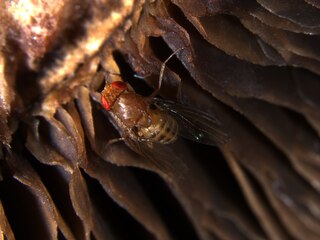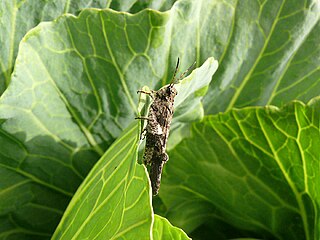
Agrotis is a genus of moths of the family Noctuidae. The genus was erected by Ferdinand Ochsenheimer in 1816. A number of the species of this genus are extinct.
The replete dart is a moth of the family Noctuidae. It is a tropical species found from Argentina and Brazil to Mexico and occurs occasionally in Florida, Louisiana and southern Texas.
The subgenus Siphlodora belongs to genus Drosophila and consists of two species that share a sigmoid-shaped posterior crossvein. Phylogenetically, the subgenus is positioned within the virilis-repleta radiation.

Drosophila is a paraphyletic subgenus of the genus Drosophila, a classification of fruit flies. This subgenus was first described by Alfred Sturtevant in 1939. Members of the subgenus Drosophila can be distinguished from other Drosophilid species by breaks in the pigmentation along the dorsal section of their abdomen.

Callopistria repleta is a moth of the family Noctuidae. It is found in India, China, Taiwan, Japan, Peninsular Malaysia, Sumatra and Borneo.

Drosophila hydei (mosca casera) is a species of Diptera, or the order of flies, in the family Drosophilidae. It is a species in the hydei species subgroup, a group in the repleta species group. Bizarrely, it is also known for having approximately 23 mm long sperm, 10 times the length of the male's body. Drosophila hydei are commonly found on compost piles worldwide, and can be rudimentarily identified by eye owing to their large size and variegated pigment pattern on the thorax. The name derives from Dr R. R. Hyde, who first discovered that the species was distinct from Drosophila repleta. D. hydei are one of the more popular flies used as feeders in the pet trade. A few varieties are available, some flightless. They are very similar to Drosophila melanogaster, despite having separated 50 million years ago.
Johann Gustav Fischer was a German herpetologist.

The banded snail sucker is a species of snake of the family Colubridae.

Drosophila repleta is a species of vinegar fly in the family Drosophilidae.
Hydroeciodes repleta is a species of cutworm or dart moth in the family Noctuidae. It is found in North America.

Anagrama is a Spanish publisher founded in 1969 by Jorge Herralde. In 2010, it was sold to the Italian publisher Feltrinelli.

Trilophidia is a genus of grasshoppers in the family Acrididae, subfamily Oedipodinae and the only member of the tribe Trilophidiini. The recorded distribution of species is from Africa and the middle-East through to Japan and Malesia.

Geophis annuliferus, also known as the western snail-eating snake, is a snake of the colubrid family. It is endemic to Mexico.

Geophis sartorii, also known commonly as Sartorius' snail-sucker and the terrestrial snail sucker, is a species of snake in the family Colubridae. The species is native to southern North America and Central America. There are two recognized subspecies.
Tropidodipsas fischeri, Fischer's snail-eating snake, is a species of snake in the family, Colubridae. It is found in Mexico, Guatemala, El Salvador, and Honduras.
Tropidodipsas guerreroensis, the Guerrero snail sucker, is a species of snake in the family, Colubridae. It is found in Mexico.
Tropidodipsas papavericola, the poppyfield snail sucker, is a species of snake in the family, Colubridae. It is found in Mexico.
Tropidodipsas philippii, Philippi's snail-eating snake, is a species of snake in the family, Colubridae. It is found in Mexico.
Tropidodipsas tricolor, the tricolor snail sucker, is a species of snake in the family, Colubridae. It is found in Mexico.
Tropidodipsas zweifeli, Zweifel's snail-eating snake, is a species of snake in the family, Colubridae. It is found in Mexico.










